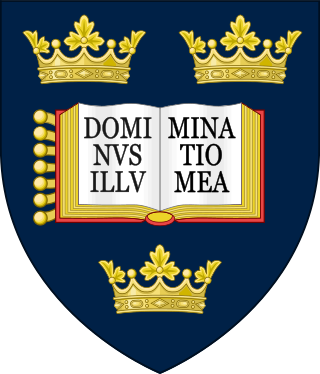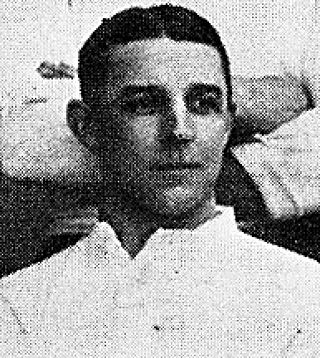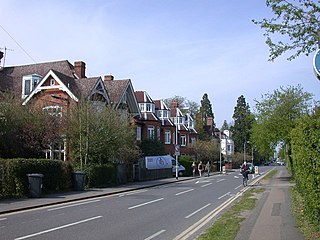
London Scottish Football Club is a rugby union club in England. The club is a member of both the Rugby Football Union and the Scottish Rugby Union. The club is currently playing in the RFU Championship and share the Athletic Ground with Richmond.

The Varsity Match is an annual rugby union fixture played between the universities of Oxford and Cambridge in England. The event began in 1872 with the first men's match, with interruptions only for the two World Wars and the COVID-19 pandemic. From 1921 to 2023 the game was played at Twickenham Stadium, London and usually took place in early December. The game is now played in March and will take place at StoneX Stadium in 2024.
Edinburgh University Rugby Football Club is a leading rugby union side based in Edinburgh, Scotland which currently plays its fixtures in the Edinburgh Regional Shield competition and the British Universities Premiership. It is one of the eight founder members of the Scottish Rugby Union. In the years prior to the SRU's introduction of club leagues in 1973 and the advent of professionalism in the 1990s, EURFC was a major club power and it won the 'unofficial' Scottish Club championship several times. It remains a club with an all-student committee, and is only open to students of the University of Edinburgh. The club runs a men's team and a women's team; both playing in the university leagues.

James Horwill is an Australian former rugby union player, who has played for the Australian national side, with 61 caps to his name. He captained the Wallabies a number of times, including during the 2011 Rugby World Cup. Horwill played ten seasons in Super Rugby for the Queensland Reds, followed by four seasons with English club Harlequins. His position was second row.
The 1902 Home Nations Championship was the twentieth series of the rugby union Home Nations Championship. Six matches were played between 11 January and 15 March. It was contested by England, Ireland, Scotland and Wales.
The 1903 Home Nations Championship was the twenty-first series of the rugby union Home Nations Championship. Six matches were played between 10 January and 21 March. It was contested by England, Ireland, Scotland and Wales.
The 1904 Home Nations Championship was the twenty-second series of the rugby union Home Nations Championship. Six matches were played between 9 January and 19 March. It was contested by England, Ireland, Scotland and Wales.
The 1906 Home Nations Championship was the twenty-fourth series of the rugby union Home Nations Championship. Six matches were played between 13 January and 17 March. It was contested by England, Ireland, Scotland and Wales.
The 1907 Home Nations Championship was the twenty-fifth series of the rugby union Home Nations Championship. Six matches were played between 12 January and 16 March. It was contested by England, Ireland, Scotland and Wales.
The 1908 Home Nations Championship was the twenty-sixth series of the rugby union Home Nations Championship. Six matches were played between 18 January and 21 March. It was contested by England, Ireland, Scotland and Wales.

David Revell "Darkie" Bedell-Sivright was a Scottish international rugby union forward who captained both Scotland and the British Isles. Born in Edinburgh, and educated at Fettes College where he learned to play rugby, he studied at Cambridge University and earned four Blues playing for them in the Varsity Match. He was first selected for Scotland in 1900 in a match against Wales. After playing in all of Scotland's Home Nations Championship matches in 1901, 1902 and 1903, Bedell-Sivright toured with the British Isles side – now known as the British & Irish Lions – that toured South Africa in 1903. After playing the first 12 matches of the tour, he was injured and so did not play in any of the Test matches against South Africa.

Thomas Sidney "Sid" Bevan was a Welsh rugby union player who represented Wales and the British Lions. Bevan played club rugby for Swansea, joining the club in 1897.

The 1904 British Isles tour to New Zealand and Australia was the sixth tour by a British Isles rugby union team and the third to New Zealand or Australia. It is retrospectively classed as one of the British Lions tours, as the Lions naming convention was not adopted until 1950.
Fred Jowett was a Welsh rugby union player who represented Wales, and the British Lions. Jowett played club rugby for Swansea, and county rugby for Glamorgan. His first and only cap was on 10 January 1903 at St Helens Ground in Swansea against England. He made his début in an experienced team, with only George Travers of Pill Harriers earning his first cap alongside Jowett. The match was a one sided affair, with Wales winning 21–5, thanks to a hat-trick of tries from Jehoida Hodges. Although playing his part in an excellent victory over England, Jowett was never selected again.
The 1903 British Isles tour to South Africa was the fifth tour by a British Isles rugby team and the third to South Africa. It is retrospectively classed as one of the British Lions tours, as the Lions naming convention was not adopted until 1950.
William Wotherspoon was a Scottish rugby union half-back who was a member of the first official British Isles tour and was also capped for the Scotland team. Wotherspoon played one game in the 1891 Championship, which saw Scotland win all three matches making Wotherspoon a Triple Crown winning player.

Grange Road is a street in Cambridge, England. It stretches north–south, meeting Madingley Road (A1303) at a T-junction to the north and Barton Road (A603) to the south. It runs approximately parallel with the River Cam to the east. Grange Road is almost one mile long and has 17th-century origins. It contains several colleges of the University of Cambridge.
The Fettesian-Lorettonians Club is a Scottish sporting club made up of former pupils of Fettes College and Loretto School. The club was founded in 1881 and has seen members of its club represent the Scotland national rugby union team.
Denys Douglas Dobson was an English international rugby union forward who played club rugby for Oxford University and Newton Abbot. Dobson played international rugby for England and the British Isles team on its 1904 tour of Australia. Dobson was the first player from a British touring rugby team to be dismissed from the playing field, when he was sent off in a match against the Northern District in Newcastle, New South Wales.










